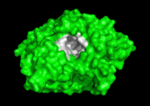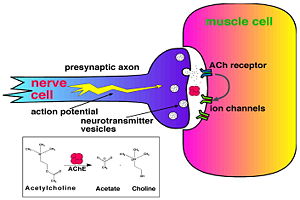Acetylcholinesterase
From Proteopedia
(Difference between revisions)
| Line 64: | Line 64: | ||
<hr/> | <hr/> | ||
| - | The photosensitizer, <scene name='Journal:Protein_Science:1/Cv/3'>methylene blue (MB)</scene> <font color='darkmagenta'><b>(colored in darkmagenta)</b></font>, generates singlet oxygen that irreversibly inhibits Torpedo californica acetylcholinesterase (''Tc''AChE). In the dark, it inhibits reversibly. | + | The photosensitizer, <scene name='Journal:Protein_Science:1/Cv/3'>methylene blue (MB)</scene> <font color='darkmagenta'><b>(colored in darkmagenta)</b></font>, generates singlet oxygen that irreversibly inhibits ''Torpedo californica'' acetylcholinesterase (''Tc''AChE). In the dark, it inhibits reversibly. |
The ''Tc''AChE active site consists of two binding subsites. One of them is the '''"catalytic anionic site" (CAS)''', which involves the catalytic triad <scene name='Journal:Protein_Science:1/Cv/6'>Ser200, His440, and Glu327</scene> <span style="color:orange;background-color:black;font-weight:bold;">(colored in orange)</span> and the conserved residues <scene name='Journal:Protein_Science:1/Cv/8'>Trp84 and Phe330</scene> which also participate in ligand recognition. Another conserved residue <scene name='Journal:Protein_Science:1/Cv/9'>Trp279</scene> <span style="color:cyan;background-color:black;font-weight:bold;">(colored in cyan)</span> is situated at the second binding subsite, termed the '''"peripheral anionic site" (PAS)''', ~14 Å from CAS. <scene name='Journal:Protein_Science:1/Cv/10'>Thioflavin T</scene> ([[2j3q]]) is a good example of the '''PAS-binding''' AChE inhibitors. <scene name='Journal:Protein_Science:1/Cv/11'>Superposition</scene> of the structure of known '''CAS-binding''' inhibitor <font color='crimson'><b>edrophonium</b></font>/''Tc''AChE ([[2ack]]) on the <font color='magenta'><b>thioflavin T</b></font>/''Tc''AChE complex structure ([[2j3q]]) shows that these <scene name='Journal:Protein_Science:1/Cv/12'>ligands' positions do not overlap</scene> <ref name="Ravelli">PMID:10089512</ref> <ref name="Sonoda">PMID:18512913</ref>. | The ''Tc''AChE active site consists of two binding subsites. One of them is the '''"catalytic anionic site" (CAS)''', which involves the catalytic triad <scene name='Journal:Protein_Science:1/Cv/6'>Ser200, His440, and Glu327</scene> <span style="color:orange;background-color:black;font-weight:bold;">(colored in orange)</span> and the conserved residues <scene name='Journal:Protein_Science:1/Cv/8'>Trp84 and Phe330</scene> which also participate in ligand recognition. Another conserved residue <scene name='Journal:Protein_Science:1/Cv/9'>Trp279</scene> <span style="color:cyan;background-color:black;font-weight:bold;">(colored in cyan)</span> is situated at the second binding subsite, termed the '''"peripheral anionic site" (PAS)''', ~14 Å from CAS. <scene name='Journal:Protein_Science:1/Cv/10'>Thioflavin T</scene> ([[2j3q]]) is a good example of the '''PAS-binding''' AChE inhibitors. <scene name='Journal:Protein_Science:1/Cv/11'>Superposition</scene> of the structure of known '''CAS-binding''' inhibitor <font color='crimson'><b>edrophonium</b></font>/''Tc''AChE ([[2ack]]) on the <font color='magenta'><b>thioflavin T</b></font>/''Tc''AChE complex structure ([[2j3q]]) shows that these <scene name='Journal:Protein_Science:1/Cv/12'>ligands' positions do not overlap</scene> <ref name="Ravelli">PMID:10089512</ref> <ref name="Sonoda">PMID:18512913</ref>. | ||
MB is a noncompetitive inhibitor of ''Tc''AChE, competing with reversible inhibitors directed at both ‘‘anionic’’ subsites, but a single site is involved in inhibition. The crystal structure reveals a <scene name='Journal:Protein_Science:1/Cv1/2'>single MB stacked against Trp279 in the PAS</scene>, oriented down the gorge toward the CAS ([[2w9i]]); it is plausible that irreversible inhibition is associated with photooxidation of this residue and others within the active-site gorge. Superposition of the '''PAS regions''' of the <font color='darkmagenta'><b>MB</b></font>/''Tc''AChE ([[2w9i]]) and <font color='magenta'><b>thioflavin T</b></font>/''Tc''AChE ([[2j3q]]) complexes reveals <scene name='Journal:Protein_Science:1/Cv1/4'>similarity between positions of these ligands</scene>. As the conformation of ''Tc''AChE in the crystal structures of the two complexes is practically identical, only that of the <font color='darkmagenta'><b>MB</b></font>/''Tc''AChE structure ([[2w9i]]) is shown. The kinetic and spectroscopic data showing that inhibitors binding at the '''CAS''' can impede binding of MB are reconciled by docking studies showing that the <scene name='Journal:Protein_Science:1/Cv2/5'>conformation adopted by Phe330</scene>, midway down the gorge, in the MB/''Tc''AChE crystal structure, precludes simultaneous binding of a second MB at the CAS (<font color='blueviolet'><b>2nd MB is colored blueviolet</b></font>, <span style="color:orange;background-color:black;font-weight:bold;">Phe330 of the crystal structure is in orange</span> and <font color='indigo'><b>Phe330 of the modeled structure is in indigo</b></font>). Conversely, binding of ligands at the '''CAS''' dislodges MB from its preferred locus at the '''PAS'''. The data presented demonstrate that TcAChE is a valuable model for understanding the molecular basis of local photooxidative damage. | MB is a noncompetitive inhibitor of ''Tc''AChE, competing with reversible inhibitors directed at both ‘‘anionic’’ subsites, but a single site is involved in inhibition. The crystal structure reveals a <scene name='Journal:Protein_Science:1/Cv1/2'>single MB stacked against Trp279 in the PAS</scene>, oriented down the gorge toward the CAS ([[2w9i]]); it is plausible that irreversible inhibition is associated with photooxidation of this residue and others within the active-site gorge. Superposition of the '''PAS regions''' of the <font color='darkmagenta'><b>MB</b></font>/''Tc''AChE ([[2w9i]]) and <font color='magenta'><b>thioflavin T</b></font>/''Tc''AChE ([[2j3q]]) complexes reveals <scene name='Journal:Protein_Science:1/Cv1/4'>similarity between positions of these ligands</scene>. As the conformation of ''Tc''AChE in the crystal structures of the two complexes is practically identical, only that of the <font color='darkmagenta'><b>MB</b></font>/''Tc''AChE structure ([[2w9i]]) is shown. The kinetic and spectroscopic data showing that inhibitors binding at the '''CAS''' can impede binding of MB are reconciled by docking studies showing that the <scene name='Journal:Protein_Science:1/Cv2/5'>conformation adopted by Phe330</scene>, midway down the gorge, in the MB/''Tc''AChE crystal structure, precludes simultaneous binding of a second MB at the CAS (<font color='blueviolet'><b>2nd MB is colored blueviolet</b></font>, <span style="color:orange;background-color:black;font-weight:bold;">Phe330 of the crystal structure is in orange</span> and <font color='indigo'><b>Phe330 of the modeled structure is in indigo</b></font>). Conversely, binding of ligands at the '''CAS''' dislodges MB from its preferred locus at the '''PAS'''. The data presented demonstrate that TcAChE is a valuable model for understanding the molecular basis of local photooxidative damage. | ||
Revision as of 02:22, 4 January 2016
| |||||||||||
Contents |
3D Structures of AChE
Updated on 04-January-2016
Additional Resources
For additional information, see:
Alzheimer's Disease
AChE inhibitors and substrates
External Links
- Acetylcholinesterase Tutorial by Karl Oberholser, Messiah College
- PDB Molecule of the Month - Acetylcholinesterase
- Movies: X-ray Damage in ACh & Nature's Vacuum Cleaner by R. Gillilan, Cornell Univ
References
- ↑ Sussman JL, Harel M, Frolow F, Oefner C, Goldman A, Toker L, Silman I. Atomic structure of acetylcholinesterase from Torpedo californica: a prototypic acetylcholine-binding protein. Science. 1991 Aug 23;253(5022):872-9. PMID:1678899
- ↑ Botti SA, Felder CE, Lifson S, Sussman JL, Silman I. A modular treatment of molecular traffic through the active site of cholinesterase. Biophys J. 1999 Nov;77(5):2430-50. PMID:10545346
- ↑ 3.0 3.1 Raves ML, Harel M, Pang YP, Silman I, Kozikowski AP, Sussman JL. Structure of acetylcholinesterase complexed with the nootropic alkaloid, (-)-huperzine A. Nat Struct Biol. 1997 Jan;4(1):57-63. PMID:8989325
- ↑ Greenblatt HM, Kryger G, Lewis T, Silman I, Sussman JL. Structure of acetylcholinesterase complexed with (-)-galanthamine at 2.3 A resolution. FEBS Lett. 1999 Dec 17;463(3):321-6. PMID:10606746
- ↑ Harel M, Schalk I, Ehret-Sabatier L, Bouet F, Goeldner M, Hirth C, Axelsen PH, Silman I, Sussman JL. Quaternary ligand binding to aromatic residues in the active-site gorge of acetylcholinesterase. Proc Natl Acad Sci U S A. 1993 Oct 1;90(19):9031-5. PMID:8415649
- ↑ Bar-On P, Millard CB, Harel M, Dvir H, Enz A, Sussman JL, Silman I. Kinetic and structural studies on the interaction of cholinesterases with the anti-Alzheimer drug rivastigmine. Biochemistry. 2002 Mar 19;41(11):3555-64. PMID:11888271
- ↑ Haviv H, Wong DM, Greenblatt HM, Carlier PR, Pang YP, Silman I, Sussman JL. Crystal packing mediates enantioselective ligand recognition at the peripheral site of acetylcholinesterase. J Am Chem Soc. 2005 Aug 10;127(31):11029-36. PMID:16076210 doi:http://dx.doi.org/10.1021/ja051765f
- ↑ 8.0 8.1 Ravelli RB, Raves ML, Ren Z, Bourgeois D, Roth M, Kroon J, Silman I, Sussman JL. Static Laue diffraction studies on acetylcholinesterase. Acta Crystallogr D Biol Crystallogr. 1998 Nov 1;54(Pt 6 Pt 2):1359-66. PMID:10089512
- ↑ 9.0 9.1 Harel M, Sonoda LK, Silman I, Sussman JL, Rosenberry TL. Crystal structure of thioflavin T bound to the peripheral site of Torpedo californica acetylcholinesterase reveals how thioflavin T acts as a sensitive fluorescent reporter of ligand binding to the acylation site. J Am Chem Soc. 2008 Jun 25;130(25):7856-61. Epub 2008 May 31. PMID:18512913 doi:http://dx.doi.org/10.1021/ja7109822
- ↑ Greenblatt HM, Guillou C, Guenard D, Argaman A, Botti S, Badet B, Thal C, Silman I, Sussman JL. The complex of a bivalent derivative of galanthamine with torpedo acetylcholinesterase displays drastic deformation of the active-site gorge: implications for structure-based drug design. J Am Chem Soc. 2004 Dec 1;126(47):15405-11. PMID:15563167 doi:http://dx.doi.org/10.1021/ja0466154
- ↑ Kryger G, Silman I, Sussman JL. Structure of acetylcholinesterase complexed with E2020 (Aricept): implications for the design of new anti-Alzheimer drugs. Structure. 1999 Mar 15;7(3):297-307. PMID:10368299
- ↑ Sanson B, Nachon F, Colletier JP, Froment MT, Toker L, Greenblatt HM, Sussman JL, Ashani Y, Masson P, Silman I, Weik M. Crystallographic Snapshots of Nonaged and Aged Conjugates of Soman with Acetylcholinesterase, and of a Ternary Complex of the Aged Conjugate with Pralidoxime (dagger). J Med Chem. 2009 Jul 30. PMID:19642642 doi:10.1021/jm900433t
- ↑ Paz A, Roth E, Ashani Y, Xu Y, Shnyrov VL, Sussman JL, Silman I, Weiner L. Structural and functional characterization of the interaction of the photosensitizing probe methylene blue with Torpedo californica acetylcholinesterase. Protein Sci. 2012 Jun 1. doi: 10.1002/pro.2101. PMID:22674800 doi:10.1002/pro.2101
Treatments:AChE Inhibitor References
Treatments:Alzheimer's Disease
Proteopedia Page Contributors and Editors (what is this?)
Michal Harel, Joel L. Sussman, Alexander Berchansky, David Canner, Eran Hodis, Clifford Felder, Jaime Prilusky, Harry Greenblatt, Yechun Xu


